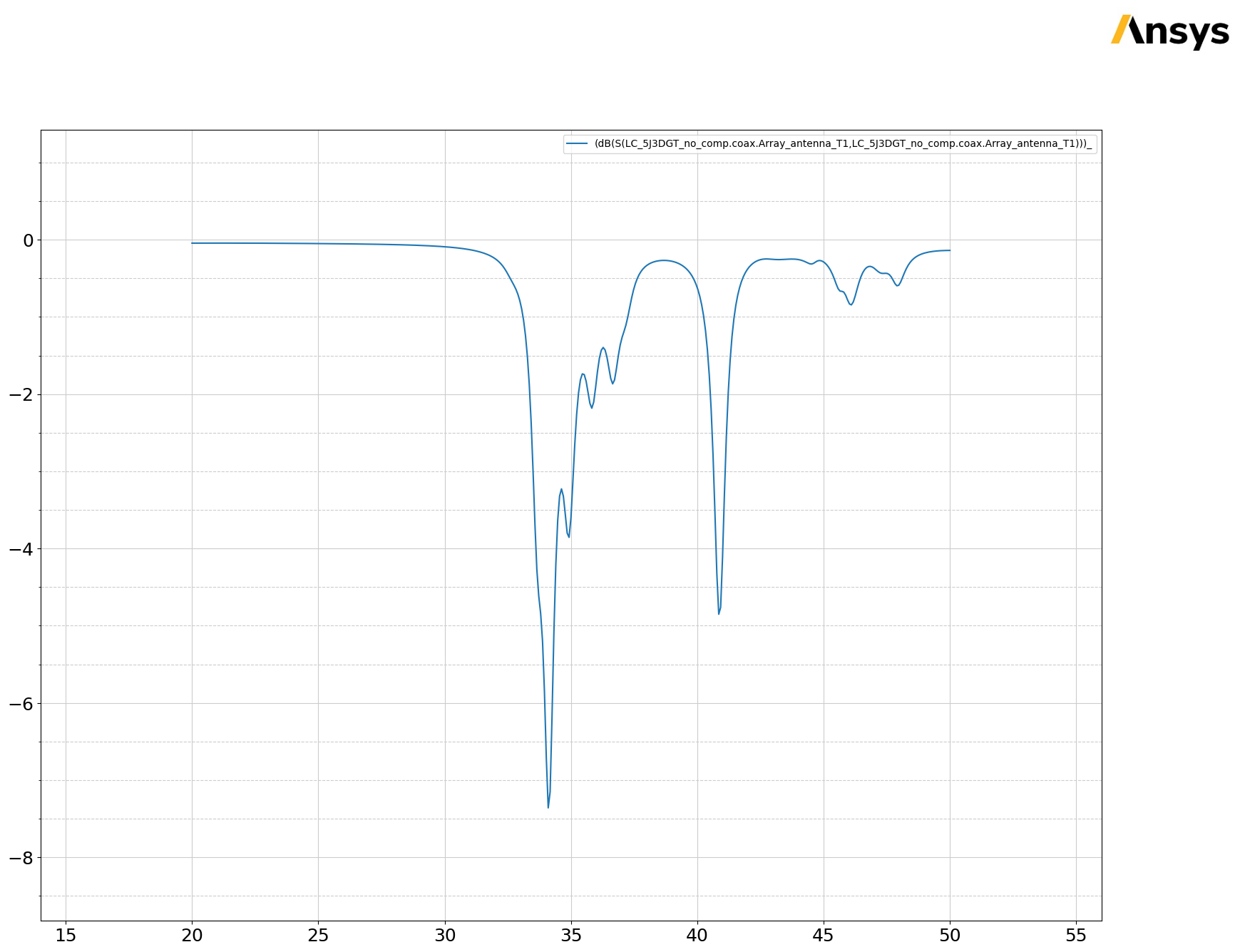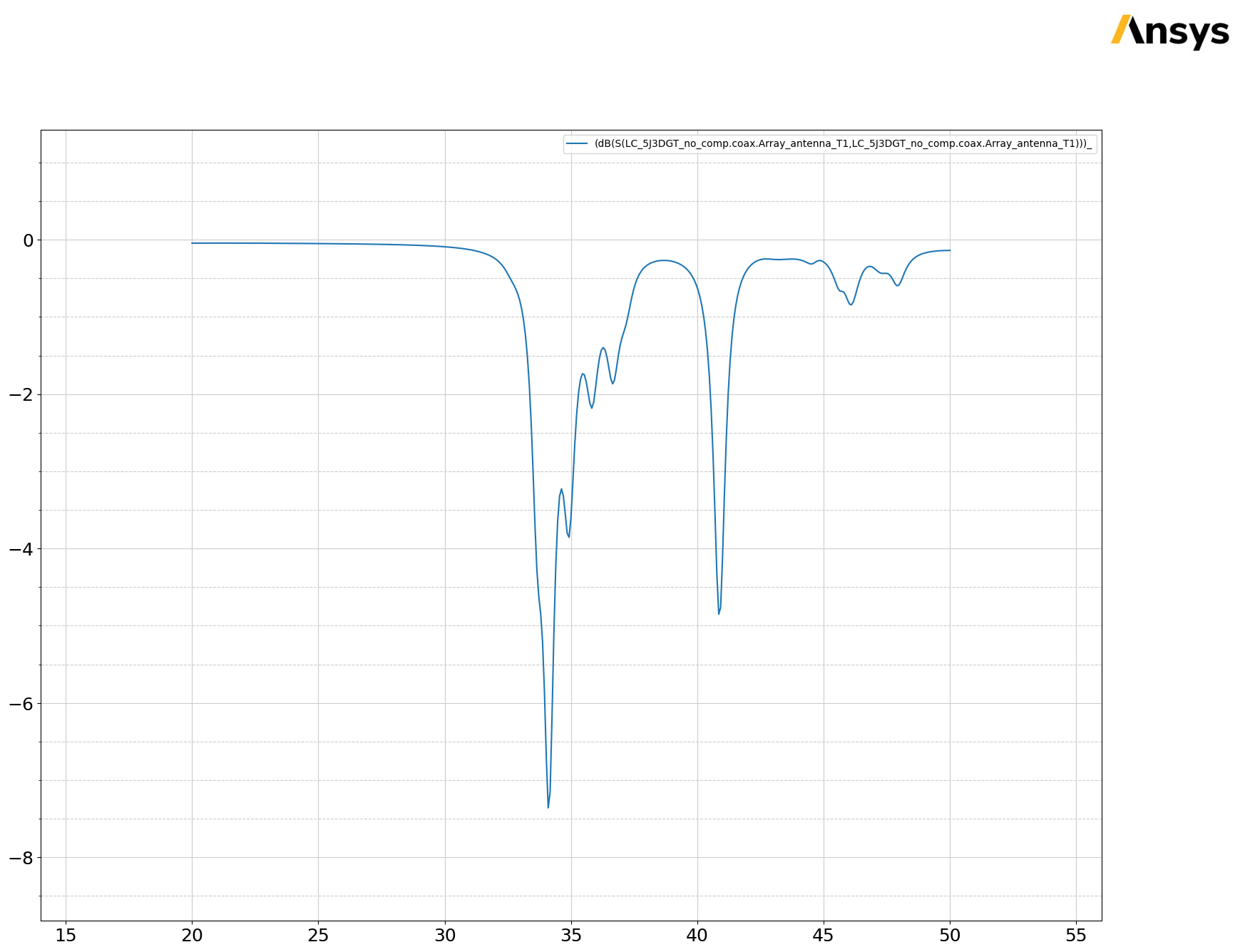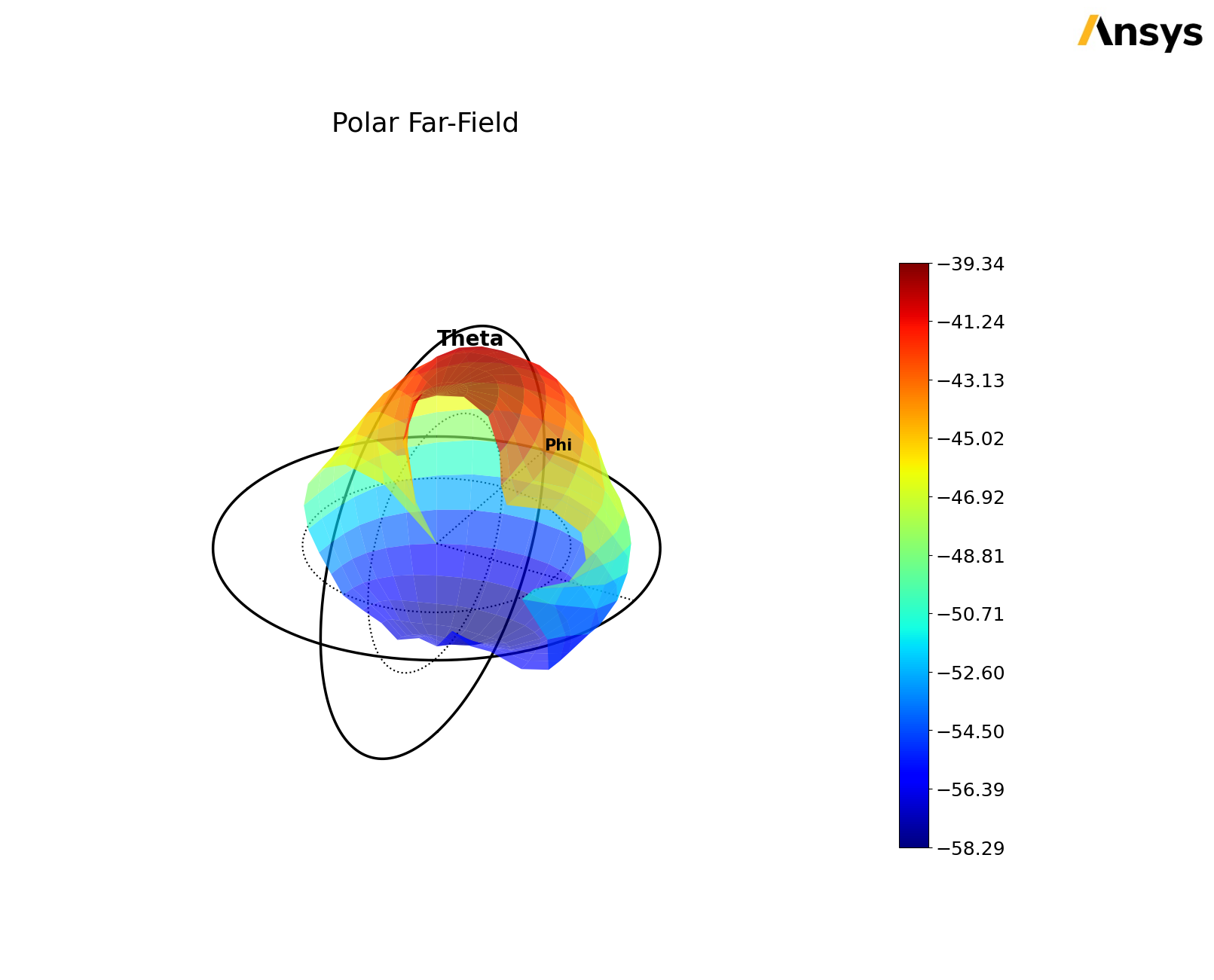Download this example
Download this example as a Jupyter Notebook or as a Python script.
EDB: Layout Components#
This example shows how you can use EDB to create a parametric component using 3D Layout and use it in HFSS 3D.
Perform required imports#
Perform required imports.
[1]:
import os
import tempfile
import ansys.aedt.core
import pyedb
Set non-graphical mode#
[2]:
non_graphical = False
Create data classes#
Data classes are useful to do calculations and store variables. There are three data classes: Patch, Line, and Array.
[3]:
class Patch:
def __init__(self, width=0.0, height=0.0, position=0.0):
self.width = width
self.height = height
self.position = position
@property
def points(self):
return [
[self.position, "-{}/2".format(self.height)],
["{} + {}".format(self.position, self.width), "-{}/2".format(self.height)],
["{} + {}".format(self.position, self.width), "{}/2".format(self.height)],
[self.position, "{}/2".format(self.height)],
]
class Line:
def __init__(self, length=0.0, width=0.0, position=0.0):
self.length = length
self.width = width
self.position = position
@property
def points(self):
return [
[self.position, "-{}/2".format(self.width)],
["{} + {}".format(self.position, self.length), "-{}/2".format(self.width)],
["{} + {}".format(self.position, self.length), "{}/2".format(self.width)],
[self.position, "{}/2".format(self.width)],
]
class LinearArray:
def __init__(self, nb_patch=1, array_length=10e-3, array_width=5e-3):
self.nbpatch = nb_patch
self.length = array_length
self.width = array_width
@property
def points(self):
return [
[-1e-3, "-{}/2-1e-3".format(self.width)],
["{}+1e-3".format(self.length), "-{}/2-1e-3".format(self.width)],
["{}+1e-3".format(self.length), "{}/2+1e-3".format(self.width)],
[-1e-3, "{}/2+1e-3".format(self.width)],
]
Launch EDB#
PyEDB.Edb allows to open existing Edb project or create a new empty project.
[4]:
temp_dir = tempfile.TemporaryDirectory(suffix=".ansys")
aedb_path = os.path.join(temp_dir.name, "linear_array.aedb")
# Select EDB version (change it manually if needed, e.g. "2025.1")
edb_version = "2025.2"
print(f"EDB version: {edb_version}")
# Create an instance of the Edb class.
edb = pyedb.Edb(edbpath=aedb_path, edbversion=edb_version)
EDB version: 2025.2
C:\actions-runner\_work\pyaedt-examples\pyaedt-examples\.venv\lib\site-packages\pyedb\misc\decorators.py:55: UserWarning: Argument `edbversion` is deprecated for method `Edb`; use `version` instead.
warnings.warn(
C:\actions-runner\_work\pyaedt-examples\pyaedt-examples\.venv\lib\site-packages\pyedb\generic\design_types.py:301: UserWarning: Your ANSYS AEDT version is eligible to gRPC version.You might consider switching to that version for better user experience.For more information please check this link: https://edb.docs.pyansys.com/version/dev/grpc_api/index.html
warnings.warn(GRPC_GENERAL_WARNING, UserWarning)
PyEDB INFO: Star initializing Edb 05:04:21.525417
PyEDB INFO: Edb version 2025.2
PyEDB INFO: Logger is initialized. Log file is saved to C:\Users\ansys\AppData\Local\Temp\pyedb_ansys.log.
PyEDB INFO: legacy v0.65.2
PyEDB INFO: Python version 3.10.11 (tags/v3.10.11:7d4cc5a, Apr 5 2023, 00:38:17) [MSC v.1929 64 bit (AMD64)]
PyEDB INFO: create_edb completed in 8.6168 seconds.
PyEDB INFO: EDB C:\Users\ansys\AppData\Local\Temp\tmpk4twou82.ansys\linear_array.aedb created correctly.
PyEDB INFO: EDB initialization completed in 8.6805 seconds.
[5]:
# Add stackup layers
layers = {
"materials": {"copper_high_cond": {"conductivity": 60000000}},
"layers": {
"TOP": {"type": "signal", "thicness": "35um", "material": "copper_high_cond"},
"Substrat": {"type": "dielectric", "thicness": "0.5mm", "material": "Duroid (tm)"},
"GND": {"type": "signal", "thicness": "35um", "material": "copper"},
"Gap": {"type": "dielectric", "thicness": "0.05mm", "material": "Air"},
"Virt_GND": {"type": "signal", "thicness": "35um", "material": "copper"},
},
}
[6]:
edb.stackup.load(layers)
[6]:
True
Create the first patch and feed line using the Patch, Lineclasses defined above.
Define parameters:
[7]:
edb["w1"] = 1.4e-3
edb["h1"] = 1.2e-3
edb["initial_position"] = 0.0
edb["l1"] = 2.4e-3
edb["trace_w"] = 0.3e-3
first_patch = Patch(width="w1", height="h1", position="initial_position")
edb.modeler.create_polygon(first_patch.points, "TOP", net_name="Array_antenna")
[7]:
<pyedb.dotnet.database.edb_data.primitives_data.EdbPolygon at 0x1a949a7c370>
First line
[8]:
first_line = Line(length="l1", width="trace_w", position=first_patch.width)
edb.modeler.create_polygon(first_line.points, "TOP", net_name="Array_antenna")
[8]:
<pyedb.dotnet.database.edb_data.primitives_data.EdbPolygon at 0x1a91540bb20>
Now use the LinearArray class to create the array.
[9]:
edb["w2"] = 2.29e-3
edb["h2"] = 3.3e-3
edb["l2"] = 1.9e-3
edb["trace_w2"] = 0.2e-3
patch = Patch(width="w2", height="h2")
line = Line(length="l2", width="trace_w2")
linear_array = LinearArray(nb_patch=8, array_width=patch.height)
current_patch = 1
current_position = "{} + {}".format(first_line.position, first_line.length)
while current_patch <= linear_array.nbpatch:
patch.position = current_position
edb.modeler.create_polygon(patch.points, "TOP", net_name="Array_antenna")
current_position = "{} + {}".format(current_position, patch.width)
if current_patch < linear_array.nbpatch:
line.position = current_position
edb.modeler.create_polygon(line.points, "TOP", net_name="Array_antenna")
current_position = "{} + {}".format(current_position, line.length)
current_patch += 1
linear_array.length = current_position
Add the ground conductor.
[10]:
edb.modeler.create_polygon(linear_array.points, "GND", net_name="GND")
[10]:
<pyedb.dotnet.database.edb_data.primitives_data.EdbPolygon at 0x1a95b99e740>
Add the connector pin to use to assign the port.
[11]:
edb.padstacks.create(padstackname="Connector_pin", holediam="100um", paddiam="0", antipaddiam="200um")
con_pin = edb.padstacks.place(
["{}/4.0".format(first_patch.width), 0],
"Connector_pin",
net_name="Array_antenna",
fromlayer="TOP",
tolayer="GND",
via_name="coax",
)
PyEDB INFO: Padstack Connector_pin create correctly
Add a connector ground.
[12]:
edb.modeler.create_polygon(first_patch.points, "Virt_GND", net_name="GND")
edb.padstacks.create("gnd_via", "100um", "0", "0")
edb["via_spacing"] = 0.2e-3
con_ref1 = edb.padstacks.place(
[
"{} + {}".format(first_patch.points[0][0], "via_spacing"),
"{} + {}".format(first_patch.points[0][1], "via_spacing"),
],
"gnd_via",
fromlayer="GND",
tolayer="Virt_GND",
net_name="GND",
)
con_ref2 = edb.padstacks.place(
[
"{} + {}".format(first_patch.points[1][0], "-via_spacing"),
"{} + {}".format(first_patch.points[1][1], "via_spacing"),
],
"gnd_via",
fromlayer="GND",
tolayer="Virt_GND",
net_name="GND",
)
con_ref3 = edb.padstacks.place(
[
"{} + {}".format(first_patch.points[2][0], "-via_spacing"),
"{} + {}".format(first_patch.points[2][1], "-via_spacing"),
],
"gnd_via",
fromlayer="GND",
tolayer="Virt_GND",
net_name="GND",
)
con_ref4 = edb.padstacks.place(
[
"{} + {}".format(first_patch.points[3][0], "via_spacing"),
"{} + {}".format(first_patch.points[3][1], "-via_spacing"),
],
"gnd_via",
fromlayer="GND",
tolayer="Virt_GND",
net_name="GND",
)
PyEDB INFO: Padstack gnd_via create correctly
Define the port.
[13]:
edb.padstacks.set_solderball(con_pin, "Virt_GND", isTopPlaced=False, ballDiam=0.1e-3)
port_name = edb.padstacks.create_coax_port(con_pin)
Display the model using the Edb.nets.plot() method.
[14]:
edb.nets.plot()

PyEDB INFO: Plot Generation time 0.301
[14]:
(<Figure size 6000x3000 with 1 Axes>,
<Axes: title={'center': 'Edb Top View Cell_0FEWMD'}>)
The EDB is complete. Now close the EDB and import it into HFSS as a “Layout Component”.
[15]:
edb.save_edb()
edb.close_edb()
print("EDB saved correctly to {}. You can import in AEDT.".format(aedb_path))
PyEDB INFO: Save Edb file completed in 0.0000 seconds.
PyEDB INFO: Close Edb file completed in 0.0158 seconds.
EDB saved correctly to C:\Users\ansys\AppData\Local\Temp\tmpk4twou82.ansys\linear_array.aedb. You can import in AEDT.
3D component in HFSS#
First create an instance of the pyaedt.Hfss class. If you set > ``non_graphical = False
then AEDT user interface will be visible after the following cell is executed. It is now possible to monitor the progress in the UI as each of the following cells is executed. All commands can be run without the UI by changing the value of non_graphical.
[16]:
h3d = ansys.aedt.core.Hfss(
project="Demo_3DComp",
design="Linear_Array",
version="2025.2",
new_desktop=True,
non_graphical=non_graphical,
close_on_exit=True,
solution_type="Terminal",
)
PyAEDT INFO: Python version 3.10.11 (tags/v3.10.11:7d4cc5a, Apr 5 2023, 00:38:17) [MSC v.1929 64 bit (AMD64)].
PyAEDT INFO: PyAEDT version 0.24.dev0.
PyAEDT INFO: Initializing new Desktop session.
PyAEDT INFO: Log on console is enabled.
PyAEDT INFO: Log on file C:\Users\ansys\AppData\Local\Temp\pyaedt_ansys_18a51e39-ff17-4fa8-9a88-920c9dedfafd.log is enabled.
PyAEDT INFO: Log on AEDT is disabled.
PyAEDT INFO: Starting new AEDT gRPC session.
PyAEDT INFO: AEDT installation Path C:\Program Files\ANSYS Inc\v252\AnsysEM
PyAEDT INFO: Client application successfully started.
PyAEDT INFO: New AEDT gRPC session session started on port 50051.
PyAEDT INFO: 2025.2 version started with process ID 5128.
PyAEDT WARNING: Service Pack is not detected. PyAEDT is currently connecting in Insecure Mode.
PyAEDT WARNING: Please download and install latest Service Pack to use connect to AEDT in Secure Mode.
PyAEDT INFO: Debug logger is disabled. PyAEDT methods will not be logged.
PyAEDT INFO: Project Demo_3DComp has been created.
PyAEDT INFO: Added design 'Linear_Array' of type HFSS.
PyAEDT INFO: Aedt Objects correctly read
Set units to mm.
[17]:
h3d.modeler.model_units = "mm"
PyAEDT INFO: Modeler class has been initialized! Elapsed time: 0m 0sec
Import the EDB as a 3D component#
One or more layout components can be imported into HFSS. The combination of layout data and 3D CAD data helps streamline model creation and setup.
[18]:
component = h3d.modeler.insert_layout_component(aedb_path, parameter_mapping=True)
PyEDB INFO: Star initializing Edb 05:05:05.405717
PyEDB INFO: Edb version 2025.2
PyEDB INFO: Logger is initialized. Log file is saved to C:\Users\ansys\AppData\Local\Temp\pyedb_ansys.log.
PyEDB INFO: legacy v0.65.2
PyEDB INFO: Python version 3.10.11 (tags/v3.10.11:7d4cc5a, Apr 5 2023, 00:38:17) [MSC v.1929 64 bit (AMD64)]
PyEDB INFO: Database linear_array.aedb Opened in 2025.2
PyEDB INFO: Cell Cell_0FEWMD Opened
PyEDB INFO: Builder was initialized.
PyEDB INFO: open_edb completed in 0.0115 seconds.
PyEDB INFO: EDB initialization completed in 0.0160 seconds.
C:\actions-runner\_work\pyaedt-examples\pyaedt-examples\.venv\lib\site-packages\pyedb\misc\decorators.py:55: UserWarning: Argument `edbversion` is deprecated for method `Edb`; use `version` instead.
warnings.warn(
C:\actions-runner\_work\pyaedt-examples\pyaedt-examples\.venv\lib\site-packages\pyedb\generic\design_types.py:301: UserWarning: Your ANSYS AEDT version is eligible to gRPC version.You might consider switching to that version for better user experience.For more information please check this link: https://edb.docs.pyansys.com/version/dev/grpc_api/index.html
warnings.warn(GRPC_GENERAL_WARNING, UserWarning)
PyEDB INFO: Close Edb file completed in 0.0000 seconds.
PyAEDT INFO: Parsing C:\Users\ansys\AppData\Local\Temp\Demo_3DComp.aedt.
PyAEDT INFO: File C:\Users\ansys\AppData\Local\Temp\Demo_3DComp.aedt correctly loaded. Elapsed time: 0m 0sec
PyAEDT INFO: aedt file load time 0.015677690505981445
PyEDB INFO: Star initializing Edb 05:05:07.111601
PyEDB INFO: Edb version 2025.2
PyEDB INFO: Logger is initialized. Log file is saved to C:\Users\ansys\AppData\Local\Temp\pyedb_ansys.log.
PyEDB INFO: legacy v0.65.2
PyEDB INFO: Python version 3.10.11 (tags/v3.10.11:7d4cc5a, Apr 5 2023, 00:38:17) [MSC v.1929 64 bit (AMD64)]
PyEDB WARNING: AEDT project-related file C:\Users\ansys\AppData\Local\Temp\Demo_3DComp.aedb\LayoutComponents\linear_array0\linear_array0.aedt.lock exists and may need to be deleted before opening the EDB in HFSS 3D Layout.
PyEDB INFO: Database linear_array0.aedb Opened in 2025.2
PyEDB INFO: Cell Cell_0FEWMD Opened
PyEDB INFO: Builder was initialized.
PyEDB INFO: open_edb completed in 0.0082 seconds.
PyEDB INFO: EDB initialization completed in 0.0159 seconds.
Expose the component parameters#
If a layout component is parametric, you can expose and change parameters in HFSS
[19]:
component.parameters
w1_name = "{}_{}".format("w1", h3d.modeler.user_defined_component_names[0])
h3d[w1_name] = 0.0015
Radiation Boundary Assignment#
The 3D domain includes the air volume surrounding the antenna. This antenna will be simulted from 20 GHz - 50 GHz.
A “radiation boundary” will be assigned to the outer boundaries of the domain. This boundary should be roughly one quarter wavelength away from the radiating structure:
[20]:
h3d.modeler.fit_all()
h3d.modeler.create_air_region(2.8, 2.8, 2.8, 2.8, 2.8, 2.8, is_percentage=False)
h3d.assign_radiation_boundary_to_objects("Region")
PyAEDT INFO: Boundary Radiation Rad__U8QFDV has been created.
[20]:
Rad__U8QFDV
Set up analysis#
The finite element mesh is adapted iteratively. The maximum number of adaptive passes is set using the MaximumPasses property. This model converges such that the \(S_{11}\) is independent of the mesh. The default accuracy setting is:
[21]:
setup = h3d.create_setup()
setup.props["Frequency"] = "20GHz"
setup.props["MaximumPasses"] = 10
Specify properties of the frequency sweep:
[22]:
sweep1 = setup.add_sweep(sweepname="20GHz_to_50GHz")
sweep1.props["RangeStart"] = "20GHz"
sweep1.props["RangeEnd"] = "50GHz"
sweep1.update()
PyAEDT WARNING: Argument `sweepname` is deprecated for method `add_sweep`; use `name` instead.
[22]:
True
Solve the project
[23]:
h3d.analyze()
PyAEDT INFO: Project Demo_3DComp Saved correctly
PyAEDT INFO: Solving all design setups. Analysis started...
PyAEDT INFO: Design setup None solved correctly in 0.0h 3.0m 2.0s
[23]:
True
Plot results outside AEDT#
Plot results using Matplotlib.
[24]:
trace = h3d.get_traces_for_plot()
solution = h3d.post.get_solution_data(trace[0])
solution.plot()
PyAEDT INFO: Parsing C:\Users\ansys\AppData\Local\Temp\Demo_3DComp.aedt.
PyAEDT INFO: File C:\Users\ansys\AppData\Local\Temp\Demo_3DComp.aedt correctly loaded. Elapsed time: 0m 0sec
PyAEDT INFO: aedt file load time 0.04208850860595703
PyAEDT INFO: PostProcessor class has been initialized! Elapsed time: 0m 0sec
PyAEDT INFO: PostProcessor class has been initialized! Elapsed time: 0m 0sec
PyAEDT INFO: Post class has been initialized! Elapsed time: 0m 0sec
PyAEDT INFO: Solution Data Correctly Loaded.
Time to initialize solution data:0.015662193298339844
Time to initialize solution data:0.015662193298339844
[24]:


Plot far fields in AEDT#
Plot radiation patterns in AEDT.
[25]:
variations = {}
variations["Freq"] = ["20GHz"]
variations["Theta"] = ["All"]
variations["Phi"] = ["All"]
h3d.insert_infinite_sphere(name="3D")
new_report = h3d.post.reports_by_category.far_field("db(RealizedGainTotal)", h3d.nominal_adaptive, "3D")
new_report.variations = variations
new_report.primary_sweep = "Theta"
new_report.create("Realized2D")
[25]:
True
Plot far fields in AEDT#
Plot radiation patterns in AEDT
[26]:
new_report.report_type = "3D Polar Plot"
new_report.secondary_sweep = "Phi"
new_report.create("Realized3D")
[26]:
True
Plot far fields outside AEDT#
Plot radiation patterns outside AEDT
[27]:
solutions_custom = new_report.get_solution_data()
solutions_custom.plot_3d()
PyAEDT INFO: Solution Data Correctly Loaded.
Time to initialize solution data:0.021393537521362305
Time to initialize solution data:0.021393537521362305
[27]:
Class: ansys.aedt.core.visualization.plot.matplotlib.ReportPlotter

Plot E Field on nets and layers#
Plot E Field on nets and layers in AEDT
[28]:
h3d.post.create_fieldplot_layers_nets(
[["TOP", "Array_antenna"]],
"Mag_E",
intrinsics={"Freq": "20GHz", "Phase": "0deg"},
plot_name="E_Layers",
)
PyAEDT INFO: Active Design set to Linear_Array
[28]:
Class: ansys.aedt.core.visualization.post.field_data.FieldPlot
Close AEDT#
After the simulation completes, the application can be released from the :func:ansys.aedt.core.Desktop.release_desktop method. All methods provide for saving the project before closing AEDT.
[29]:
h3d.save_project(os.path.join(temp_dir.name, "test_layout.aedt"))
h3d.release_desktop()
PyAEDT INFO: Project test_layout Saved correctly
PyEDB INFO: Close Edb file completed in 0.0113 seconds.
PyAEDT INFO: Desktop has been released and closed.
[29]:
True
Clean up the temporary directory#
The following command removes the project and the temporary directory. If you’d like to save this project, save it to a folder of your choice prior to running the following cell.
[30]:
temp_dir.cleanup()
Download this example
Download this example as a Jupyter Notebook or as a Python script.
